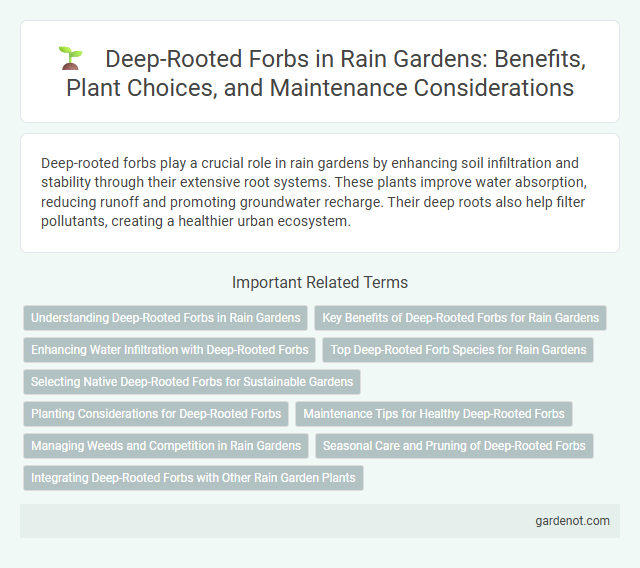Deep-rooted forbs play a crucial role in rain gardens by enhancing soil infiltration and stability through their extensive root systems. These plants improve water absorption, reducing runoff and promoting groundwater recharge. Their deep roots also help filter pollutants, creating a healthier urban ecosystem.
Understanding Deep-Rooted Forbs in Rain Gardens
Deep-rooted forbs in rain gardens enhance soil aeration and improve water infiltration by developing extensive root systems that penetrate deeply into the substrate. These plants contribute to nutrient cycling and erosion control, supporting the rain garden's ecological function and resilience during heavy rainfall events. Selecting native species such as Echinacea purpurea and Asclepias tuberosa ensures adaptability and promotes local biodiversity within rain garden ecosystems.
Key Benefits of Deep-Rooted Forbs for Rain Gardens
Deep-rooted forbs in rain gardens enhance stormwater absorption by penetrating deep soil layers, reducing surface runoff and erosion. Their extensive root systems improve soil aeration and nutrient cycling, promoting healthier plant communities and increasing biodiversity. These plants also support pollinators and wildlife, contributing to the ecological resilience of rain garden ecosystems.
Enhancing Water Infiltration with Deep-Rooted Forbs
Deep-rooted forbs significantly enhance water infiltration in rain gardens by penetrating compacted soil layers, creating channels for water to percolate deeper into the ground. Their extensive root systems increase soil porosity and promote microbial activity, improving overall soil structure and water retention capacity. Selecting native deep-rooted forb species like purple coneflower (Echinacea purpurea) and black-eyed Susan (Rudbeckia hirta) optimizes rain garden performance by reducing surface runoff and supporting groundwater recharge.
Top Deep-Rooted Forb Species for Rain Gardens
Top deep-rooted forb species for rain gardens include Echinacea purpurea, Rudbeckia hirta, and Asclepias tuberosa, which effectively enhance water infiltration and soil stability. These species possess extensive root systems that improve stormwater management by reducing runoff and supporting nutrient uptake. Incorporating native deep-rooted forbs promotes biodiversity and resilience in rain garden ecosystems.
Selecting Native Deep-Rooted Forbs for Sustainable Gardens
Selecting native deep-rooted forbs enhances rain garden sustainability by improving soil structure and maximizing water infiltration. Species like Echinacea purpurea and Rudbeckia hirta provide extensive root systems that stabilize soil and support local biodiversity. These forbs also promote resilience to drought and reduce erosion, making them essential for eco-friendly garden designs.
Planting Considerations for Deep-Rooted Forbs
Deep-rooted forbs require well-drained, loamy soil to promote deep root penetration and sustained moisture access in rain gardens. Selecting native species adapted to local climate and soil conditions enhances survival rates and ecological benefits, such as pollinator support. Spacing plants adequately reduces competition for nutrients and allows for mature root expansion, improving overall rain garden function.
Maintenance Tips for Healthy Deep-Rooted Forbs
Deep-rooted forbs in rain gardens require minimal watering once established due to their extensive root systems that enhance drought tolerance. Periodic mulching helps retain soil moisture and suppress weeds, promoting robust growth and nutrient uptake. Regular inspection for pests and timely pruning of dead or damaged stems ensure optimal plant health and longevity in rain garden ecosystems.
Managing Weeds and Competition in Rain Gardens
Deep-rooted forbs play a crucial role in managing weeds and competition within rain gardens by establishing strong root systems that outcompete invasive species for nutrients and water. Their deep roots improve soil structure and moisture retention, reducing the likelihood of weed proliferation. Selecting native, deep-rooted forb species enhances rain garden resilience by promoting biodiversity and minimizing maintenance efforts.
Seasonal Care and Pruning of Deep-Rooted Forbs
Deep-rooted forbs in rain gardens benefit from seasonal care that includes monitoring soil moisture and mulching to support root health during dry periods. Pruning should be performed in late winter or early spring to remove dead foliage, stimulate new growth, and maintain plant vigor. Proper seasonal maintenance enhances pollutant filtration and water infiltration capacities of rain garden ecosystems.
Integrating Deep-Rooted Forbs with Other Rain Garden Plants
Deep-rooted forbs enhance rain garden resilience by improving soil aeration and water infiltration, complementing shallow-rooted grasses and shrubs. Integrating diverse species with varying root depths creates a more efficient water absorption system, reducing surface runoff and promoting pollutant filtration. Strategic planting of deep-rooted forbs alongside native sedges and rushes optimizes ecosystem services and supports local biodiversity.
Deep-rooted forb Infographic

 gardenot.com
gardenot.com